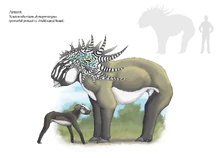
The armox is the largest of all circuagodonts, and one of the largest tribbetheres on land after the omniphages; it weighs up to 1,200 lbs. A descendant of the antlears, this species - a native of the northern taiga - has traded the dexterity of its mobile spiked ears for strength. With enormously wide, heavily armored ears that both rotate at their base and fold halfway along their length, the armox's ears have evolved into defensive shields that can be swung quickly around to protect the neck of the killing bites of large predators, such as the predatory grappler birds, and swept forward over the face to protect the eyes and snout from the sharp, slicing bites of the carnivorous circuagodonts.
Today bulky and fairly slow runners, armox are most immediately descended from a much more gracile ancestor that adapted to run on only one primary toe per limb, with the other digits shrinking or being lost entirely. Though speed is no longer its defense, the armox retains a single large hoof on each foot, with a pair of smaller, mostly vestigial dewclaws on each leg behind it.
Armox are very social herd-dwellers, relying on the collective defense of many individuals to form a living wall around their more vulnerable young, who take many years to develop their antlers to their fullest extent. Few predators, even the largest, can break through such a barrier. The only negative of the enormity of their horns is that the armox has lost the original benefit they provided as grasping manipulators and must feed closer to ground level. Perhaps because of this, it is primarily a far-northern species, living where trees rarely grow past its head height anyway and so avoiding being relegated to feed only on the sparse undergrowth of the taller southern forests. Their jaws function like loppers, cutting large branches which the creature chews and consumes entirely, wood and all.
Gallery[]

Animation of an armox walking.
